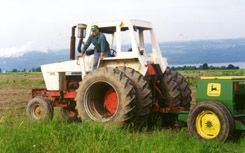Abstract
For a final project for EE 476 at Cornell University under the instruction of Bruce Land I designed and built a fertilizer flow rate control unit tailored to the needs of Lin Davidson. Instead of conventional mechanical drive methods, the delivery rate was controlled through the use of an Atmel AT90S8515 microcontroller. Ground speed of the tractor was sensed through the use of a radar unit acquired from Dickey-John, the fertilizer delivery rate is actuated by an electric gearmotor, controlled through a PID feedback loop that modifies a PWM output, designed to give a constant delivery of fertilizer for every unit area of ground. As the tractor speeds up, the rate at which fertilizer is dispensed increases, and vice versa. At this point the project is in a prototype phase, where a first generation product is ready to be mounted on a tractor and tested. Because of the timing of the project (being ready for testing during planting season) it is not realistic to spend time modifying necessary farm equipment by adding a product that is not guaranteed to work. In a few week’s time, the project will be mounted on a tractor/planter and tested for possible future use.
Introduction
The general premise is that farmers need to fertilize their crops. Under-fertilization causes problems with slow growth, while over-fertilization can waist fertilizer, damage the soil, or even kill the plants being fertilized. The most common method for fertilizer delivery is controlling the delivery rate based on a timing wheel that rolls along the ground. This has disadvantages because uneven soil causes the timing wheel to rotate faster than it should, delivering too much fertilizer; muddy ground or poor traction in general means that the timing wheel will rotate too slowly or not at all, meaning too little fertilizer. Additionally, adjusting the fertilizer flow rate can be a difficult time consuming mechanical task. By using a radar unit (similar to those used by police) the actual ground speed of the tractor can be sensed independent of the ground conditions. The output of the radar unit must then be converted into a control signal for the motor that drives the fertilizer drops. Under this design, adjusting the fertilizer flow rate relative to the ground speed is as simple as pressing a button. The rest of this web page is dedicated to the design and construction of an interface to accomplish this task, based around an Atmel AT90S8515 microcontroller.
For more detail: Fertilizer Feed Rate Controller

